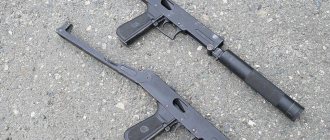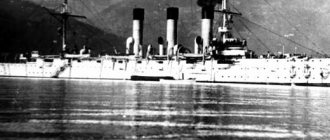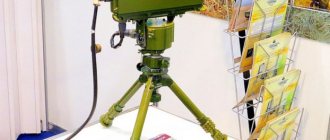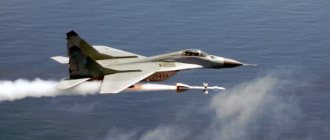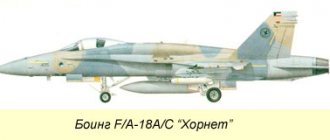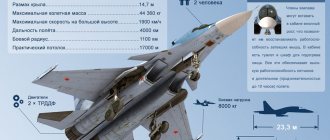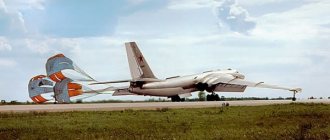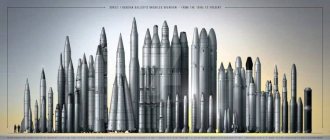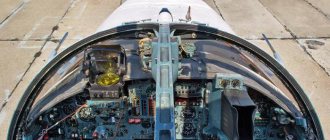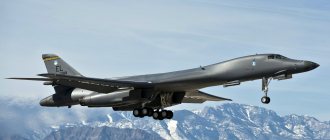Su-32 front-line bomber.
Su-32 front-line bomber.
Developer: Sukhoi Design Bureau Country: Russia First flight: 1994
Su-32 is an export strike version of the Su-34 front-line bomber. It was first presented at international exhibitions in 1995. This aircraft will be equipped with coastal aviation. The main applications are anti-ship, anti-submarine and other strike operations in a zone of enhanced air defense.
In December 1994, the first production T-10V-5 took off, and in 1995 it was already presented at the Paris Air Show. By that time, its name had changed to Su-32FN (in English transcription Su-32FN, which meant Su-32 Fighter Navy - naval fighter). Obviously, they decided that it would be difficult to find people willing to buy a front-line bomber on the world market, and if they offered an aircraft for the defense of sea borders, it would be easier to sell it. The size of the vehicle and its internal volumes make it possible to install a large number of equipment for various purposes to solve specific problems, including combating ships and submarines. Preliminary studies were carried out at the Design Bureau in 1995-1997. It was proposed, leaving the basic complex practically unchanged, to place submarine search equipment in the tail fairing - magnetometers and sonar buoys, and also to supplement the range of weapons with new anti-ship missiles of the Mosquito (ЗМ80) and Alpha type, the latter can be suspended up to four pieces. In addition, there was information in the press about the creation of a reconnaissance and jammer aircraft based on the Su-32FN, but representatives of the Design Bureau have not yet officially confirmed this information.
Double all-metal cantilever mid-wing, made according to the “triplane” design, equipped with an additional PGO, with two engines and a three-post retractable landing gear, using a two-wheeled nose landing gear with a reinforced strut. It has no ventral fins. The airframe of the aircraft is made of aluminum-lithium alloys with limited use of titanium and stainless steels. The wing, integrally coupled with the fuselage, is trapezoidal and has a sweep along the leading edge of 42°. The PGO is made all-rotating. The stabilizer is differentially deflectable. The crew's workstations are located side by side, one next to the other, “shoulder to shoulder,” which significantly reduces their fatigue and improves interaction. The crew is in a closed pressurized cabin equipped with a heating and air conditioning system. Entry is through the nose landing gear via a folding ladder. The cabin itself is made as a single armored capsule. The armor is titanium. The wall thickness reaches 17 mm. The glazing is also armored. 2 ejection seats of the K-39DM type allow you to emergency leave a stationary vehicle. The power plant consists of an AL-35F turbofan engine with an afterburner thrust of 12,800 kg. The aircraft is equipped with an in-flight refueling system.
Saturday, December 27, 1997, at the airfield of the Novosibirsk Aviation Production Association (NAPO) named after V.P. Chkalov, pleased with good weather: clear skies, frost around -14°C, moderate wind. According to the plan, runs of the second Su-32 aircraft of the installation series are scheduled for 11.00, and the first flight the next day. However, according to the report of the head of the flight test station, Yuri Nagorny, “the weather forecast shows” snowfall for Sunday. NAPO General Director Alexander Bobryshev, after several minutes of reflection, sets a new date for the first flight - today, at 15:00. At 11:00 the plane slowly taxis onto the runway from the direction of the flight test station. Run-up - braking, run-up - braking. At the end of the runway, the plane turns around and returns to its original position. High-speed taxiing with the nose wheel raised - also without any comments. Traditional analysis in the office of the head of the LIS. Reports of the test pilot of NAPO im. V.P. Chkalov Evgeniy Rudakas and test pilot of Sukhoi Design Bureau OJSC Igor Solovyov confirm: the aircraft is ready for flight. 15:05. The hum of powerful engines breaks the silence over the airfield. A quick, short run-up, and the graceful car dissolves into the sky. 15:45. The specialists surrounding the aircraft in the parking lot are already congratulating the pilots and each other: the Su-32 installation series has been replenished with a new model.
The Su-32 coastal reconnaissance and attack aircraft is designed to search for and destroy enemy surface ships and submarines at a considerable distance from the defended territory. The aircraft is capable of effectively defending the maritime economic zone of coastal states day and night in conditions of bad weather and radio countermeasures. In addition, the flight characteristics of the Su-32 aircraft, along with a highly automated complex of avionics and a powerful set of air-to-air guided missiles, make it possible to provide reliable protection against airborne attack weapons operating from sea directions.
The two-seat supersonic aircraft Su-32, being, according to the currently accepted classification, a new fourth-generation aircraft, inherited a number of high-tech technologies from its famous predecessor - the Su-27 family fighter. The contours of its wing, stabilizer and vertical tail correspond to the Su-27 aircraft. Like the Su-27, it has an integral aerodynamic configuration and an adaptive wing, the leading and trailing edges of which automatically, based on commands from a digital multi-channel fly-by-wire control system, track the current values of the angle of attack and overload. On the Su-32, the same system automatically controls the position of the anti-aircraft gun.
The specific combat mission of the Su-32 led to a number of differences in the design of the aircraft. The fuselage and landing gear have undergone significant changes. The most characteristic thing is the new cockpit: the pilot and navigator-operator are placed in a welded armored cockpit “side by side” for their best interaction. The cabin is optimized for long flights (pilots can get out of their seats, straighten up to their full height, and eat hot food).
The life support system maintains air pressure in the cabin up to an altitude of 10 km, allowing the crew to work without oxygen masks. The K-36DM ejection seats allow emergency escape from the vehicle in all flight modes, including ejection from ground level at zero speed.
The basic concept of the Su-32 aircraft, its unparalleled appearance, as well as the ideology of the cockpit, which ensures high combat survivability of the aircraft and comfortable working conditions for the crew, were formed directly by the general designer of Sukhoi Design Bureau OJSC Mikhail Petrovich Simonov. The general designer included in the project the most promising developments of domestic on-board radio-electronic equipment. The architectonics he chose, in combination with the multiplex information exchange channel, makes it possible to painlessly replace individual avionics systems with more advanced ones as the Su-32 aircraft develops.
The aircraft is equipped with the Sea Serpent avionics system, designed for reconnaissance, monitoring the surface of the sea, searching for submarines, detecting mines and combating surface ships. The structure of the complex is separate-integral. All information systems are configured as autonomous equipment, which includes computing units of the Argon on-board computer. The modular design of the entire complex, a certain duplication of software and equipment, as well as the simultaneous operation of all information systems make it possible to complete a combat mission even if part of the information systems fails. In addition, the separate design makes it easy to change the configuration of the complex, that is, to make it less complex and expensive or to add some new information systems if necessary.
All components of the complex are controlled through a central computer system, which provides complete coordination of work, data exchange and intelligent assistance to the crew of the Su-32 aircraft when performing a combat mission in the entire range of operating conditions. When performing a maritime patrol mission, the Su-32 aircraft ensures the collection of data on the presence of a target in a given search area, and the detection of radar and acoustic unmasking signs of a target. Under certain conditions, optical unmasking signs of a target at a great distance are detected. At the same time, the complex allows for monitoring the coastal situation and monitoring the situation in ports. In addition, the coherent radar of the Sea Serpent complex detects and locates air targets (including small ones) located above the sea at a distance of 150-200 km. Maritime patrol is supported by radar, electronic reconnaissance system and infrared television system.
The task of combating surface ships is solved through the use of the above-mentioned information systems. The aircraft is located at the maximum possible distance from the coverage area of shipborne air defense systems and operates in conditions of active and passive interference. The anti-ship weapons of the Su-32 aircraft are located on 12 external units under the fuselage, engine nacelles and wing consoles. The total weight of weapons is 8000 kg. It includes anti-ship guided missiles ASM-MSS, ASM-MS with a range of up to 250 km, anti-ship guided missiles ASM-M with a range of 70 km, anti-ship missiles ASM-M2 with a range of 180 km, guided missiles AGM-TTC with television command guidance system, torpedoes, sonobuoys and air-to-air guided missiles. Suspension of conventional aerial bombs is possible.
The Su-32 aircraft with the Sea Serpent avionics complex independently solves all anti-submarine missions without exception, and can also participate in the search for a submarine, determining its location, tracking it and destroying the boat after establishing by other means the fact of its presence. The intelligent crew assistance system ensures the continuity of the combat mission without operator intervention, providing several solution options. In this case, the operator’s responsibility is to monitor the automatic execution of the combat mission until a decision is made. At the operator's workplace there are two indicators with a large rectangular CRT display and a liquid crystal panel. Indicators allow simultaneous display of information data from various systems. The onboard submarine detection equipment includes:
Radar in combination with sonobuoys, including passive directional sonobuoys operating in the range of sound and infrasonic frequencies, active directional sonobuoys and means of blast wave generation. In terms of their characteristics, they surpass the well-known American buoys of the SSQ-53B, SSQ-77A, SSQ-75 types.
Radar as a means of detecting small objects (for example, submarine periscopes and snorkels), monitoring the operation of sonobuoys, and navigation. The characteristics of the radar exceed those of the American AN/APS-137 radar. It should be noted that the equipment and associated software included in the sonar system can be easily modified and adapted to work with sonobuoys used in the UK.
A magnetometer that records the distortion of the Earth's magnetic field caused by the presence of a submarine. Its characteristics are similar to the well-known systems AN/ASQ-81 or AH/ASQ-502. The effectiveness of detecting magnetic anomalies and tracking a boat with its help can be increased when combined with a sonobuoy system.
IR television system with television (optical) and infrared channels for receiving data that can be used independently or jointly, taking into account weather conditions and time of day.
Electronic reconnaissance system (the main mode of operation is standby, and at the same time can detect, identify and determine the direction of the radio equipment of an over-the-horizon underwater target).
Central computing control system.
The combat capabilities of the Su-32 attract everyone's attention around the world. According to many foreign experts, the Su-32 aircraft is a new aviation weapon system for offensive-defensive purposes with expanded capabilities for action against ground, surface/underwater targets at a considerable distance from the coastline, with the ability to conduct air patrols to detect and destroy sea targets while maintaining highly effective ability to operate against air targets. It should be noted that the specificity and complexity of the combat missions solved by the Su-32 do not limit the possibility of creating new modifications at the request of the customer.
Su-32 aircraft were exhibited twice (in 1995 and 1997) at the most prestigious air show in Le Bourget, arousing great attention from specialists and the general admiration of visitors.
In the spring of 1997, NAPO completed production of the pilot batch aircraft - T-10V-6 (tail number 46). Its first flight was carried out on December 27, 1997. At the same time, the pace of construction and testing of the Su-34 was falling; the next vehicle (T-10V-7, tail number 47) was only brought to the airfield three years later. Its flyby took place on December 22, 2000. By that time, the Su-34, officially presented by the Sukhoi Design Bureau under the name Su-32MF (“multifunctional”) since 1999, had become a world record holder. On July 28, 1999, test pilot of the Sukhoi Design Bureau Igor Votintsev and test navigator Alexander Gaivoronsky, starting from the GLITs airfield of the Russian Ministry of Defense in Akhtubinsk on one of the first production aircraft presented to the FAI administration as Su-32MF No. 66003, reached a flight altitude of 14727 m with a load of 5000 kg. The take-off weight of the aircraft in this flight, during which three more records were simultaneously set (flight altitude with a load of 1 and 2 tons and the maximum weight of cargo raised to a height of 2000 m), was 36160 kg, which corresponded to the C-11 class in the group 3 - jet aircraft with a take-off weight of 35-45 tons.
A week later, on August 3, a similar record-breaking flight was undertaken by GLITs military test pilots - pilot Vyacheslav Petrusha and navigator Alexander Oshchepkov, who reached a height of 15063 m with a load of 5 tons and lifted a load of 5129 kg to a height of 2000 m (two records). This time the take-off weight of the Su- 32MF was 34130 kg (class S-1k, group 3, take-off weight 25-35 tons).
Three more world aviation records were set on the Su-32MF during the Sukhoi Design Bureau Day at MAKS-99 on August 19, 1999, test pilot Igor Solovyov and test navigator Vladimir Shendrik, taking off from the airfield of the Gromov Flight Research Institute, improved their recent achievements colleagues Votintsev and Gaivoronsky, reaching a flight altitude of 16206 m with a load of 1 and 2 tons, and set a new record for the mass of cargo raised to a height of 15000 m - 2330 kg. Records were recorded in the class of jet aircraft with a take-off weight of 35-45 tons.
Documents on the record flights of the Su-32MF were transferred to the FAI International Aeronautical Federation and on March 29, 2000, were registered as five official world aviation records. As of 2005, three of them (flight altitude with a load of 5 tons in two classes and lifting a load to a height of 15 km) are still listed as operating.
The main differences between the Su-32FN aircraft and the Su-34 aircraft: - the composition of the avionics has been slightly changed: it includes a modified radar with improved performance over the sea and an increased detection range of surface targets, a new optical-electronic surveillance and sighting system with thermal imaging, television and laser channels, magnetometer; navigation and communications equipment, reconnaissance equipment and electronic control equipment were modified; - the use of 72 radio-hydroacoustic buoys (active, passive and explosive acoustic generators) located in the ventral container is ensured; - the armament additionally includes 2 heavy anti-ship missiles weighing 4000 kg each with a launch range of 150 km, 3 anti-ship missiles weighing 1500 kg each with a launch range of 250 km, 4 anti-submarine homing torpedoes.
The aircraft's armament is divided into cannon-gun, air-to-air guided missile, air-to-surface guided missile, unguided missile and bomber. Small arms and cannon armament is represented by a built-in automatic rapid-fire single-barrel 30 mm caliber cannon, installed in the influx of the right half of the wing, with 150 rounds of ammunition. Missile and bomber weapons are placed on aircraft launchers (APU), aircraft ejection devices (ACU) and beam holders (BD), suspended at 12 points: 6 - under the wing consoles, 2 - under the wingtips, 2 - under the engine nacelles and 2 — under the center section between the engine nacelles (according to the “tandem” scheme).
The aircraft can carry up to 8 medium-range air-to-air guided missiles of the R-27 type with semi-active radar (R-27R, R-27ER) or thermal (R-27T, R-27ET) homing heads, up to 10 medium-range missiles range RVV-AE with active radar homing heads and up to 6 short-range maneuverable missiles with thermal homing heads. A typical aircraft armament for air-to-air missions consists of 8 R-27E (or RVV-AE) missiles and 4 R-73 missiles.
The air-to-surface guided weapons include 6 Kh-29T general-purpose missiles with television homing heads, 6 Kh-29L, Kh-25ML or S-25LD missiles with semi-active laser homing heads, 6 KAB-500Kr adjustable bombs with television - correlation homing heads or KAB-500L with semi-active laser homing heads, 3 Kh-59M medium-range missiles with a television-command guidance system, 3 KAB-1500 adjustable bombs, 6 Kh-31A anti-ship missiles with active radar homing heads and 6 anti-radar missiles Kh-31P with passive radar homing heads. The modification of the Su-32FN is additionally expected to provide the use of heavy anti-ship missiles ASM-MSS and ASM-MS.
The maximum weight of unguided air-to-surface weapons is 8000 kg. It may include 3 FAB-1500M54 bombs, 16 FAB-500M54 bombs or 14 FAB-500M62 bombs or 14 ZB-500 incendiary tanks or 36 FAB-250M54 bombs (on single-lock and multi-lock beam holders), 48 OFAB-100- bombs 120 (on multi-lock beam holders), 8 KMGU containers, 120 S-8 unguided missiles (in 6 B-8M1 blocks), 30 S-13 missiles (in 6 UB-13 blocks), 6 S-25 missiles (in launchers O-25).
LTH:
Modification: Su-32 Wing span, m: 14.70 Length, m: 22.00 Height, m: 5.93 Wing area, m2: 62.00 Weight, kg - empty: 22300 - normal take-off: 42000 - maximum take-off : 44600 Engine type: 2 x TRDDF AL-35F Thrust, kgf: 2 x 12800 Maximum speed, km/h - at altitude: 1900 (M=1.8) - at the ground: 1400 Practical ceiling, m: 17000 Practical range, km: 4000 Maximum operational load: 9 Crew, persons: 2 Armament: 30-mm GSh-301 cannon installed in the right wing overflow. Up to 8000 kg of combat load is suspended on 8 underwing and 4 ventral pylons: -6 air-to-air missiles R-73; -8 R-27 air-to-air missiles of various modifications; -10 air-to-air missiles R-77 (RVV-AE); -6 air-to-surface missiles X-29T/L; -6 air-to-radar missiles Kh-31P or air-to-ship Kh-31A; -6 S-25 guided air-to-surface missiles; -1 multi-purpose missile launcher "Alpha"; -3 air-to-surface missiles X-59M; -3 adjustable aerial bombs KAB-1500L/TK; -6 adjustable aerial bombs KAB-500KR/L; -6 B-8M launchers, 20 80-mm S-8 NURS; 6 UB-13 launchers, 5 122-mm S-13 NURS; 6 disposable O-25 launchers for 6 266/340 mm or 256/420 mm NURS S-25; -12-16 500 kg aerial bombs; 22 250 kg aerial bombs; 34 100 kg aerial bombs; 7 KMGU containers.
Su-32 at the MAKS-1999 air show.
Su-32 on takeoff.
Su-32 at Le Bourget. Drawing.
Su-32. Scheme.
.
.
List of sources: Wings of Russia. “Su-27 and its modifications” Aviation and Time. Andrey Fomin. The Thirty-Four attacks from the air. Wings of the Motherland. Sergey Safonov. Seven years later. Wings of the Motherland. Nikolai Yakubovich. Attack aircraft of the 21st century. Airplane. A. Nikiforov. Su with a mustache. Bulletin of Aviation and Cosmonautics. Su-32 front-line bomber. Wings of the Motherland. Rollan Martirosov. The Su-32 superplane is a breakthrough into the 21st century. Aerial panorama. Rollan Martirosov. Su-32FN: “Sea Serpent” striking from the sky.
Su-34 Dimensions. Engine. Weight. Story. Range of flight. Service ceiling
Su-34 is a Russian multifunctional fighter-bomber designed to carry out air strikes against enemy ground targets in operational and tactical depth in conditions of strong opposition from enemy air defense systems due to its unique combat qualities and the use of modern electronic warfare systems and destruction of enemy air targets. day and night in simple and difficult weather conditions.
